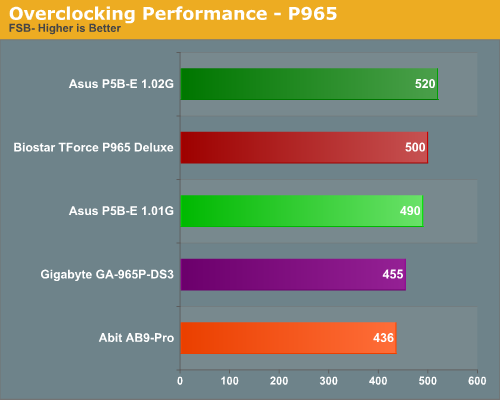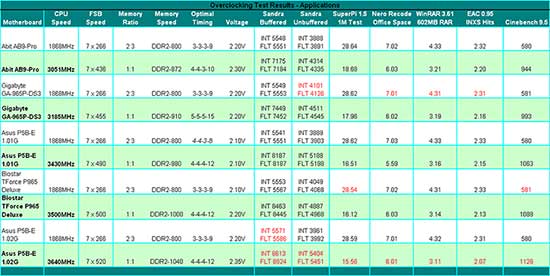Intel P965: Mid-Range Performance Sector Roundup
by Gary Key on October 20, 2006 9:00 PM EST- Posted in
- Motherboards
Overclocking Performance

We have already reviewed the overclocking capabilities of each board in detail during our review of the boards' feature sets if addtional information is required about the results. As a recap our ASUS P5B-E 1.02G motherboard is our top overclocking board. It is able to overclock further with our GEIL PC2-6400 memory than the ASUS P5B-E 1.01G board due to the additional memory voltage options. The Biostar TForce P965 board is limited to 500FSB due to its BIOS options. Our Gigabyte GA-965P-DS3 is limited to the 450FSB range due to issues overclocking our Micron D9 1GB modules and the Abit AB9-Pro is just limited at this time. We will now take a look at how our boards performed in a few of our standard benchmarks while overclocked.
Our end results are not that surprising as the higher you overclock a system the greater its performance will be and in this case that means the ASUS P5B-E 1.02G walks away with the trophy. In our application benchmarks that tend to be very CPU intensive we see the benefits of overclocking as our Nero Recode test shows an improvement of 16% on average with our WinRAR tests showing upwards of a 36% increase in performance. Our audio encoding test only showed an improvement of 11% but this is due to the fact that the CPU was waiting on the optical drive during the encoding process as it takes two minutes and three seconds to extract the audio files. In our Sandra memory results we see the Gigabyte GA-965P-DS3 having the highest Unbuffered results which directly translates to its class leading performance in our benchmarks. We also took notice of the very consistent performance from the Biostar TForce P965 Deluxe board which has the second highest Sandra Unbuffered test results.
In our gaming benchmarks we see differences of 7% in Quake 4, up to 38% in Battlefield 2, and 59% in the older Serious Sam II title. This trend shows a definite improvement in the CPU/GPU balanced titles with little improvement in a title like Quake 4 that is already becoming GPU limited at 1280x1024. We implemented 4xAA in Quake 4 and the game shows no real differences in performance once it becomes GPU limited. Battlefield 2 still shows a 22% improvement but the spread between the Abit board and the ASUS 1.02G board is only 1% even though there is a 19% difference in the overclocking speed of the boards. Serious Sam II becomes GPU limited in a hurry when implementing 4xAA/8xAF settings although the frame rates are still very good.
Our opinion is that unless you are benchmarking to impress your friends and colleagues or are not GPU limited then there are few real gaming advantages to overclocking a system with the latest components. This basically means that to a certain degree you should invest in a very good GPU first and then start looking at the platform components based upon your timeline for keeping the system. Over time overclocking can become advantageous as you upgrade the GPU and simply overclock the system to improve CPU and memory performance. This can help extend the life of your main system components while allowing you to spend your money wisely during an upgrade cycle. Of course, there are those of us who throw this entire theory out the window (Ed: the author does this everyday!) every time a new component is introduced.

We have already reviewed the overclocking capabilities of each board in detail during our review of the boards' feature sets if addtional information is required about the results. As a recap our ASUS P5B-E 1.02G motherboard is our top overclocking board. It is able to overclock further with our GEIL PC2-6400 memory than the ASUS P5B-E 1.01G board due to the additional memory voltage options. The Biostar TForce P965 board is limited to 500FSB due to its BIOS options. Our Gigabyte GA-965P-DS3 is limited to the 450FSB range due to issues overclocking our Micron D9 1GB modules and the Abit AB9-Pro is just limited at this time. We will now take a look at how our boards performed in a few of our standard benchmarks while overclocked.
 |
 |
| Click to enlarge |
Our end results are not that surprising as the higher you overclock a system the greater its performance will be and in this case that means the ASUS P5B-E 1.02G walks away with the trophy. In our application benchmarks that tend to be very CPU intensive we see the benefits of overclocking as our Nero Recode test shows an improvement of 16% on average with our WinRAR tests showing upwards of a 36% increase in performance. Our audio encoding test only showed an improvement of 11% but this is due to the fact that the CPU was waiting on the optical drive during the encoding process as it takes two minutes and three seconds to extract the audio files. In our Sandra memory results we see the Gigabyte GA-965P-DS3 having the highest Unbuffered results which directly translates to its class leading performance in our benchmarks. We also took notice of the very consistent performance from the Biostar TForce P965 Deluxe board which has the second highest Sandra Unbuffered test results.
In our gaming benchmarks we see differences of 7% in Quake 4, up to 38% in Battlefield 2, and 59% in the older Serious Sam II title. This trend shows a definite improvement in the CPU/GPU balanced titles with little improvement in a title like Quake 4 that is already becoming GPU limited at 1280x1024. We implemented 4xAA in Quake 4 and the game shows no real differences in performance once it becomes GPU limited. Battlefield 2 still shows a 22% improvement but the spread between the Abit board and the ASUS 1.02G board is only 1% even though there is a 19% difference in the overclocking speed of the boards. Serious Sam II becomes GPU limited in a hurry when implementing 4xAA/8xAF settings although the frame rates are still very good.
Our opinion is that unless you are benchmarking to impress your friends and colleagues or are not GPU limited then there are few real gaming advantages to overclocking a system with the latest components. This basically means that to a certain degree you should invest in a very good GPU first and then start looking at the platform components based upon your timeline for keeping the system. Over time overclocking can become advantageous as you upgrade the GPU and simply overclock the system to improve CPU and memory performance. This can help extend the life of your main system components while allowing you to spend your money wisely during an upgrade cycle. Of course, there are those of us who throw this entire theory out the window (Ed: the author does this everyday!) every time a new component is introduced.










62 Comments
View All Comments
zjohnr - Tuesday, November 7, 2006 - link
In all the features tables for the motherboards in this article the PCI slots are listed as being PCI v2.3. However, looking at the pictures for the boards, the slots have PCI v2.2 keying. I think the entry in the features tables is wrong. (Is it?)Patsoe - Saturday, October 28, 2006 - link
Seeing all the trouble with the P965 - especially with the non-intel p-ata controller and with the ich8r - I'd be inclined to get a Core2-ready i945P board with ICH7R instead. Would that be a sane idea?BadThad - Tuesday, October 24, 2006 - link
Is the v1.02G Asus P5B-E using all solid capacitors? I read a press release stating that Asus was releasing the "P4B-E Plus" version with all solid caps. Rumor says the "Plus" version will not be sold in the USA.....arrgggggg. Tell me that's not true. I want the solid caps for long-term reliability. I'm wondering if our "Plus" is actually the v1.02G?Thanks
Gary Key - Tuesday, October 24, 2006 - link
The 1.01G and 1.02G boards are exactly the same except for a PLL controller. Asus stills states the P5B-Plus will not be imported into the States but you never know.keithke - Monday, October 23, 2006 - link
I was interested to hear you used this Scythe Infinity Air Cooler as I was going to do the same. Were there any issues with the Northbridge heatsink sitting so close? Or did it just plop right in with no spacing issues?Thx
Keith
Gary Key - Tuesday, October 24, 2006 - link
No issues with the Inifinity on all four corners. It is a close fit but it works fine with the enclosed fan.SniperWulf - Monday, October 23, 2006 - link
Hey guys,Did you have any strange anomolies with the X-fi on the DS3 while overclocked? When I was using that board with the F6 bios, I'd have to reboot like 3-4 times before windows would properly detect it. I eventually grew tired of it and bought a P5B-D so I haven't had a chance to try F7 with it.
Gary Key - Monday, October 23, 2006 - link
I did not have any issues with the X-FI on the DS3 when it was overclocked. The F5 and F6 BIOS releases were not X-FI friendly where F4 was perfect. F7 is working for some and not others, I did not have an issue with it. F8 will fix it for good.schlumpfi106 - Monday, October 23, 2006 - link
Im a little bit disappointed that there are so few informations about the cooling/silencing-related capabilitites of the boards. I would like to know how many fans can be connected, if the connectors are 3- or 4-pin, and if there is a way to control the fan speeds (preferably via SpeedFan). I don't care about a one-percent performance difference. My first priority is a reasonably silent system.goinginstyle - Monday, October 23, 2006 - link
He mentioned the number of fan headers on each board and even added a couple of comments on the ones that did not work right. In the features section there was a statement about whether the included utility worked or not. Sure he did not say anything about SpeedFan but how far do you want a guy to go after 26 pages? Also, if you click on the Enlarge picture on the boards you can clearly make out whether the fan headers are 3 or 4 pin.